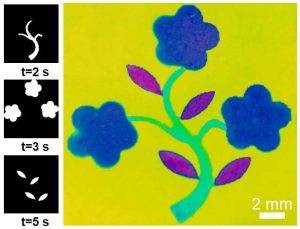Building materials with precise patterning that covers dimensions from the nano- to the macroscale is a staple of natural materials. This multiscale control is at the heart of the surprising functions that we see in the natural world all around us. Structural color is one of Nature’s most dazzling displays. These iridescences, found, among others, in shells, gemstones, plants, feathers, and butterfly wings are obtained by selective filtering of white light through ordered three-dimensional geometries that have periodically structured nanoscale lattices. Inspiration from these morphologies has led to the realization of devices with structural color that have found utility as sensors, or to encode information.
Omenetto and co-workers used a naturally occurring structural protein (silk fibroin) to generate a large (~5 cm) inverse opal that displays structural color through its nanopatterned lattice.  The large, protein-based opal surfaces provide a canvas to define and refine spectral responses by altering protein conformation and modifying the nanostructured lattice by a few tens of nanometers at a time. This is achieved through selective exposure to either water and/or light that can change silk’s conformation thus allowing to controllably define different lattice constants and “paint” different structural colors on these free-standing silk films without the need to mechanically manipulate (i.e. compress) the film itself.
The large, protein-based opal surfaces provide a canvas to define and refine spectral responses by altering protein conformation and modifying the nanostructured lattice by a few tens of nanometers at a time. This is achieved through selective exposure to either water and/or light that can change silk’s conformation thus allowing to controllably define different lattice constants and “paint” different structural colors on these free-standing silk films without the need to mechanically manipulate (i.e. compress) the film itself.
Based on this approach, mm- or sub-mm, multispectral patterns can be designed by altering the engineered nanoscale structure of centimeter-scale free-standing silk films.
Designing structural color in a natural material provides promising new avenues for photonic applications of increased utility for sensing, transduction, and spectral modulation. The rapid and irreversible response to water vapor of the silk opal surfaces can record the surrounding humidity and transduce it into color for environmentally controlled areas. The material’s biocompatibility could enable large, petri-dish sized, multispectral surfaces that could transduce cellular behavior in vitro. Finally, the ability to easily functionalize the material, both with organic and inorganic dopants, can provide a platform fort the design of active photonic devices with convenient and facile fabrication.

















